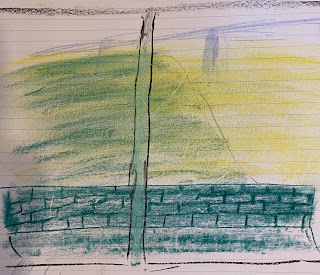This blog focuses on ways that art, technology, and literacy can interact in all educational settings.
Friday, May 13, 2022
Curriculum Unhidden
Sunday, April 24, 2022
Thinking about the Future of Conferences

Thursday, April 7, 2022
Finding my way around Fargo North Dakota and other Metacognitive tasks
 This weekend I went to Fargo, North Dakota for an athletic event. Navigating a new city is always a challenge, and I started by activating Google Maps to get everywhere in town. I quickly found out that relying on google maps without any idea about the general direction was a disorienting and challenging experience.
This weekend I went to Fargo, North Dakota for an athletic event. Navigating a new city is always a challenge, and I started by activating Google Maps to get everywhere in town. I quickly found out that relying on google maps without any idea about the general direction was a disorienting and challenging experience.
I find that planning is often missing in students' work. They write an essay, code a program, or create n art product with very little planning. The lack of planning often adds to resistance to editing and revision, which are the keys to moving from a fail to a win. It is hard to get our students to plan, but it is perhaps the most important metacognitive skill that we can teach. Make a plan, execute, iterate, and then reflect. But it all starts with a plan.
The workweek then had a significant planning session led by Kimberley D'Adamo. it was a gratifying experience to start charting the path we want to walk, making sure we feel like we know where we are going and having a reasonable plan to get there.
Tuesday, March 29, 2022
Skill, Digital Creation and memory

Sunday, March 20, 2022
Personal Reflection on Cultural Appropriation and Cowboy Hats

Sunday, March 13, 2022
Clean Your Windows so you can see the fireflies
As I was cleaning, I realized that it was an interesting metaphor that calls on me as a researcher to stop, slow down, and examine what in my process of looking at the world needs cleaning. Is the distortion I see a result of dirt/noise in my control? This can go to weak beliefs and theories that stop me from seeing clearly. It can be unrelated (yet powerful) emotion or just constant activity that prevents me from realizing what I need to be paying attention to.
This may also be true of the devices and apps we use to see the world, algorithms, scanning, and attentional processes obscure what there is to see. Once in a while, we need to stop and clean our windows making sure that we are doing our best to see what is out there. Making what we are seeing is not just the distortion on our window.
This is my Journal page, I noticed that my processing has many more questions than answers or solutions. It could very well be that many of the questions are the ways I am scaffolding my process, or it could be that this early in the research into Art TEAMS, there are questions with answers pending. Leading to one of the only declarations: I have more questions than answers.Saturday, March 5, 2022
So I went to NAEA for the first time
The National Art Education Association meeting was in New York City this spring. Despite many years of being involved in arts integration, I have never had the opportunity to go. This year after our grant application for Art TEAMS was funded Was a great opportunity to go.







